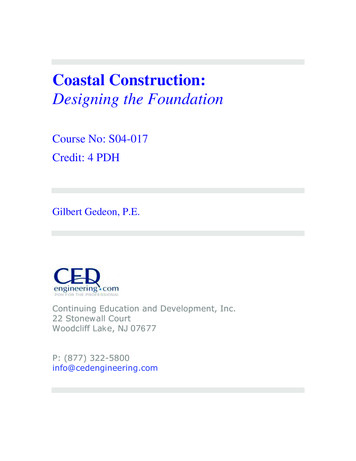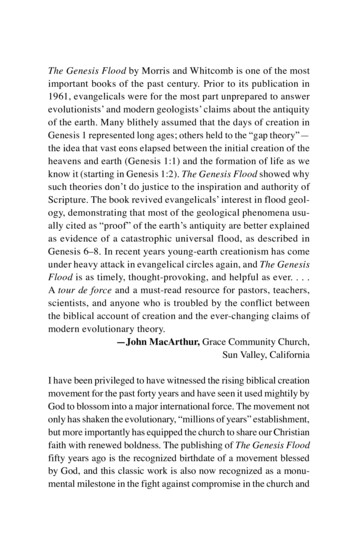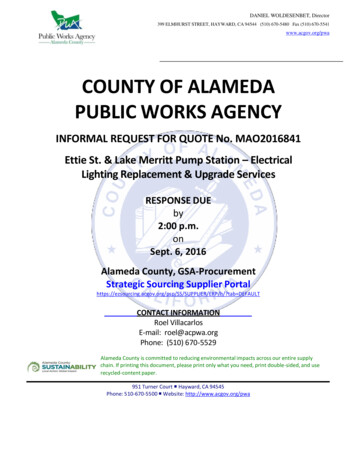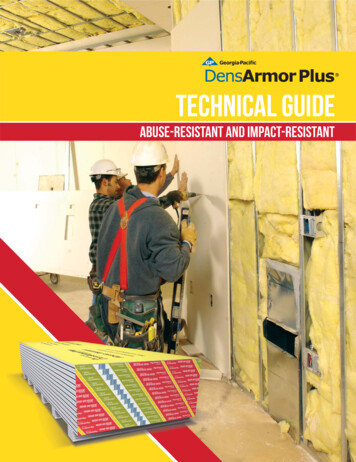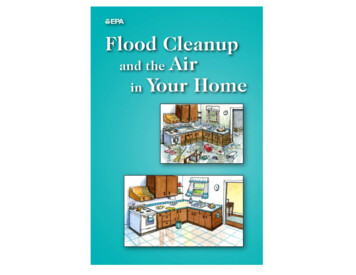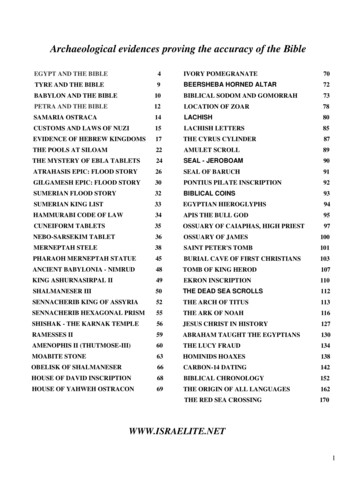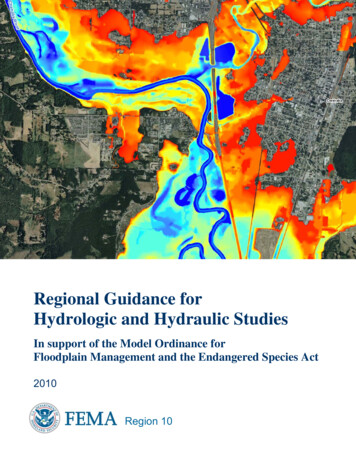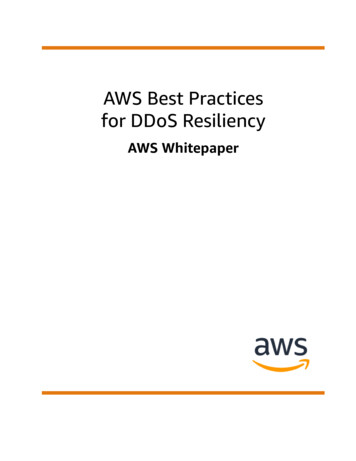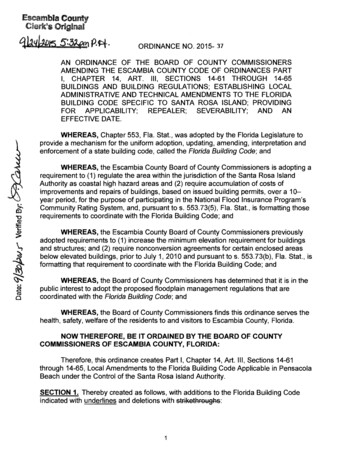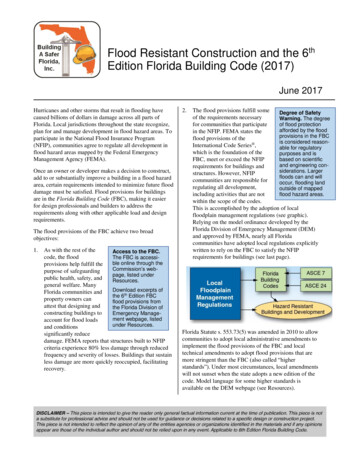
Transcription
Flood Resistant Construction and the 6thEdition Florida Building Code (2017)June 2017Hurricanes and other storms that result in flooding havecaused billions of dollars in damage across all parts ofFlorida. Local jurisdictions throughout the state recognize,plan for and manage development in flood hazard areas. Toparticipate in the National Flood Insurance Program(NFIP), communities agree to regulate all development inflood hazard areas mapped by the Federal EmergencyManagement Agency (FEMA).Once an owner or developer makes a decision to construct,add to or substantially improve a building in a flood hazardarea, certain requirements intended to minimize future flooddamage must be satisfied. Flood provisions for buildingsare in the Florida Building Code (FBC), making it easierfor design professionals and builders to address therequirements along with other applicable load and designrequirements.The flood provisions of the FBC achieve two broadobjectives:1.As with the rest of theAccess to the FBC.code, the floodThe FBC is accessible online through theprovisions help fulfill theCommission’s webpurpose of safeguardingpage, listed underpublic health, safety, andResources.general welfare. ManyDownload excerpts ofFlorida communities andthe 6th Edition FBCproperty owners canflood provisions fromattest that designing andthe Florida Division ofconstructing buildings toEmergency Management webpage, listedaccount for flood loadsunder Resources.and conditionssignificantly reducedamage. FEMA reports that structures built to NFIPcriteria experience 80% less damage through reducedfrequency and severity of losses. Buildings that sustainless damage are more quickly reoccupied, facilitatingrecovery.2.The flood provisions fulfill someDegree of Safetyof the requirements necessaryWarning. The degreefor communities that participateof flood protectionafforded by the floodin the NFIP. FEMA states theprovisions in the FBCflood provisions of theis considered reason International Code Series ,able for regulatorywhich is the foundation of thepurposes and isFBC, meet or exceed the NFIPbased on scientificand engineering conrequirements for buildings andsiderations. Largerstructures. However, NFIPfloods can and willcommunities are responsible foroccur, flooding landregulating all development,outside of mappedincluding activities that are notflood hazard areas.within the scope of the codes.This is accomplished by the adoption of localfloodplain management regulations (see graphic).Relying on the model ordinance developed by theFlorida Division of Emergency Management (DEM)and approved by FEMA, nearly all Floridacommunities have adopted local regulations explicitlywritten to rely on the FBC to satisfy the NFIPrequirements for buildings (see last page).Florida Statute s. 553.73(5) was amended in 2010 to allowcommunities to adopt local administrative amendments toimplement the flood provisions of the FBC and localtechnical amendments to adopt flood provisions that aremore stringent than the FBC (also called “higherstandards”). Under most circumstances, local amendmentswill not sunset when the state adopts a new edition of thecode. Model language for some higher standards isavailable on the DEM webpage (see Resources).
Flood Resistant ConstructionThe NFIP – and the FBC – requires communities to ensurethat new buildings and structures in flood hazard areas aredesigned and constructed to resist the effects of floodhazards and flood loads. The same requirements apply toexisting buildings if proposed work is determined toconstitute substantial improvement or repair of substantialdamage (both terms are defined in the FBC).Chapter 16 of the FBC, Building requires designers todevelop flood loads, which involves determining floodconditions (flood depth, velocity, scour/erosion, andwave/debris impact). Flood loads and load combinations aredescribed in Chapter 5 of ASCE 7, Minimum Design Loadsfor Buildings and Other Structures. Section R322 of theFBC, Residential requires dwellings to be designed andconstructed in accordance with specific provisions.Although hydrostatic load, a function of water depth, is themost obvious load and the easiest to compute, other loadsmay be more important in final designs. Flood conditionsnecessary to compute hydrodynamic loads are more difficultto determine (see graphic) and may require consultation withcivil or hydraulic engineers. The FBC, Residential requires adesign professional to prepare designs for homes in coastalhigh-hazard areas and Coastal A Zones, but not in otherflood zones (see next section for descriptions of floodzones). Designers and builders are cautioned to evaluatewhether any flood conditions (such as velocities or waves)may warrant a closer look at flood loads.Other aspects of flood-resistant construction found in theFBC include the use of flood damage-resistant materials,requirements for enclosures below elevated buildings, andthe location of electrical, plumbing, heating, ventilation, andair-conditioning (HVAC) equipment, swimming pools, andtanks.Flood Hazard Areas and FloodConditionsFlood Insurance Rate Maps (FIRMs) prepared by FEMA arethe most common flood hazard maps adopted by Floridacommunities. Designers and builders should check withindividual communities to determine whether a locallyprepared map is used for regulatory purposes. FIRMsidentify flood hazard areas associated with the base flood(the 1%-annual-chance or “100-year” flood). Some FIRMsalso identify areas subject to flooding by the less frequent500-year flood.FIRMs identify flood hazard areas based oncharacteristics of flooding: Zone A, AE, A1–30, AO, and AH. These zonesinclude flood hazard areas along rivers and streams,in isolated areas where floodwaters accumulatewithout draining to a waterway and in coastal areasinland of Zone V and along many shorelines.Floodways are designated along some rivers andstreams. Zone V, VE, V1–30, and VO. These zones identifycoastal high-hazard areas found along opencoastlines where, during the base flood, waves areexpected to be 3 feet and higher. Limit of Moderate Wave Action.When shown, the LiMWAidentifies the inland extent of 1.5foot waves and the area betweenthe LiMWA and the Zone Vboundary or shoreline is designatedas Coastal A Zone. Zone X (shaded) identifies areassubject to flooding by the 500-yearflood and Zone X (unshaded)identifies land areas that areoutside of the 100- and 500-year flood hazard areas.Coastal A Zone.Revised FIRMs forcoastal communitiesmay have a Limit ofModerate WaveAction (LiMWA)delivered. The areabetween the LiMWAand the Zone Vboundary or the shoreis designated the“Coastal A Zone.”Some site-specific flood conditions can be determinedusing FIRMs and associated Flood Insurance Studies,while others can be estimated using the best availableinformation (for a general discussion, see the checklist inAppendix C in FEMA P-936, Floodproofing NonResidential Buildings): Flood depth, used to compute lateral and verticalhydrostatic loads, is determined by subtracting theground elevation from the base flood elevation(BFE) shown on the FIRM. Lateral hydrostatic loadsneed not be considered for enclosures belowelevated buildings that have flood openings to allowfloodwater to flow in and out automatically. Vertical(buoyant) hydrostatic loads are calculated for2
elements below the BFE and may be important whensoils are saturated. Flood velocity, used to compute hydrodynamic load,may be estimated in riverine areas if the FloodInsurance Study has a floodway data table or byusing standard methods for estimating open-channelflow velocities (see FEMA’s RecommendedProcedures for Flood Velocity Data Development. Incoastal areas there is more uncertainty in estimatingflood velocity, which is speed of the mass movementof floodwater, not breaking waves (e.g., as a stormsurge moves onshore or recedes). A number ofFEMA references include a graph showing velocityas a function of stillwater flood depth (see FEMA P55, Coastal Construction Manual).Debris in moving water can impart a considerableimpact load when it collides with buildings. Whetherdebris is likely to be present, and the types and sizesof debris, cannot be determined from flood maps andstudies. ASCE 7 Chapter 5 commentary providesguidance for consideration of debris impact loads.Wave loads, important in coastal areas, dependlargely on wave height. Wave height is a function ofstillwater flood depth and may be approximatedusing information in Flood Insurance Studies. Themagnitude of wave loads can be 10 times or morethan wind forces. ASCE 7 Chapter 5 commentaryprovides guidance on determining wave loads.Erosion and scour may affect the stability offoundations and the loss of supporting soils shouldbe considered because it affects flood loads. Refer toFEMA P-55 for guidance on the effects of erosionand scour.Duration of flooding, although not a directcontribution to flood loads, is a condition thatwarrants consideration. Long-duration flooding ismore likely to delay reoccupancy and is a factor inwhether dry floodproofing measures can be used fornonresidential buildings (not allowed in Zone V).Also, long-duration flooding is likely to causenonstructural damage even if flood damage-resistantmaterials are used.If BFEs are not shown on the flood hazard map, the FBCgives the building official the authority to require thepermit applicant to obtain and use data from anothersource or to determine the design flood elevation (DFE)using accepted engineering practices. Many communitiesprovide applicants with BFE or flood depth information,and some communities may allow the use ofapproximation methods, such as interpolating the specialflood hazard area boundary based on topographicmapping.New Flood Requirements in the 6th Ed. FBC. For easyidentification in the following descriptions, underliningidentifies the flood requirements that are new to the 6 thEdition FBC.FBC, Building – Chapter 1AdministrationChapter 1 establishes the applicability of the code anddescribes how the code is to be applied and enforced.This chapter includes flood provisions in a number ofsections: Hunting “camps” are exempt from the FBC unlesscertain conditions apply, including location in the“100-year floodplain” (Sec. 102.2). Site plans should show flood hazard areas,floodways, and DFEs (Sec. 107.2.5).BFE and DFE. The codes use the term DFE, which isthe same as the BFE unless the community adopts amap showing a more extensive flood hazard area thanthe SFHA with flood elevations higher than the BFE.Some communities adopt additional maps to show areasprone to flooding outside of the SFHA. The minimum plan review criteria include floodhazard areas, flood zones, DFE, lowest floorelevations, enclosures and flood damage-resistantmaterials (Sec. 107.3.5). The authority to issue permits on the basis ofaffidavits (Sec. 105.1 and Sec. 107.6.1) does notextend to the flood load and flood resistantrequirements of the FBC to preserve the NFIPrequirement that local officials review and approvepermits. As part of required inspections, submission ofcertifications (prepared by a Florida licensedprofessional surveyor) of the lowest floor elevationare required upon placement of the lowest floor andprior to further vertical construction. Final (“asbuilt”) certifications must be submitted as part of thefinal inspection (Sec. 110.3). Certificates of occupancy are to include a statementthat the elevation certificate has been provided and isretained in the community’s records (Sec. 111.2).Also see flood provisions in Sec. 102.2.5 (certainexemptions that may be adopted by enforcementdistricts), Sec. 102.7 (relocation of manufacturedbuildings), and Sec. 117.1 (variances in flood hazardareas, which refers to local floodplain managementregulations).3
FBC, Building-The use of dry floodproofing (only nonresidentialoccupancies in Zone A) is limited depending onflood velocities and adequate warning time toimplement measures that require humanintervention. A Florida amendment to ASCE 24permits dry floodproofing in Coastal A Zonesprovided designs account for wave loads andpotential erosion and scour.-Utility equipment and machinery that servebuildings are required to be elevated or meet aspecific performance expectation. Similarrequirements are found in the FBC, Mechanical;FBC, Plumbing; and FBC, Fuel Gas.Most, but not all, flood provisions in the FBC, Buildingare found in Sec. 1612, Flood Loads (see Table 1612.1for a listing of all flood provisions in the FBC). Thefollowing highlight key provisions: In Sec. 1612.3, floodhazard areas areestablished by localfloodplain managementordinances, which adoptflood hazard maps andsupporting data. FEMAFlood Insurance Studiesand Flood Insurance RateMaps (FIRMs) arespecified. Some Floridacommunities adopt locallyprepared studies andmaps.Special DetailedRequirementsBased on Use andOccupancy. Specialdetailed requirements(Chapter 4) based onuse and occupancyinclude flood provisions in Sec. 449(hospitals), Sec. 450(nursing homes), Sec.453 (educationalfacilities), and Sec.454 (pools). Sec. 1612.5 requires submission of elevationcertification (also see Sec. 110.3, Inspections) and, ifpertinent to specific buildings, design documentationfor dry floodproofing, engineered openings,foundation and anchorage, and breakaway walls.Design documentation must be prepared and sealedby registered design professionals. Sec. 1804.4 includes requirements for grading andfill. Where allowed in flood hazard areas, fill shallbe placed, compacted, and sloped to be stable underflood conditions. Sec. 3109 includesBASF CCCL Factrequirements for buildingsSheet. Visitseaward of the Coastalwww.buildingasaferfloConstruction Control Linerida.org to download afact sheet summary of(CCCL). Areas seaward ofthe revised CCCLthe CCCL that are alsorequirements.mapped as flood hazardareas are subject to themore restrictive of the flood requirements. Thissection is revised in the 6th Edition FBC to minimizedifferences with Sec. 1612 and ASCE 24.Elevation requirements depend on flood zone. Seethe summary of elevation requirements inHighlights of ASCE 24-14 prepared by FEMA.Elevation requirements above the BFE start at 1foot (Flood Design Class 2) and go up to 2 feet orthe 500-year flood elevation, whichever is higher(Flood Design Class 4). Buildings in “high-velocity hurricane zones”(Broward and Miami-Dade counties) are required tocomply with the specific provisions for those zonesand also the requirements of Sec. 1612, if located inflood hazard areas (Sec. 1601.1).-Coastal A Zones, if designated, are treated as ZoneV, although backfilled stemwalls are permitted iffoundation designs account for scour.-Specific requirements for enclosures belowelevated buildings are based on flood zone. Allenclosure walls must have flood openings,including walls intended to breakaway under waveloads. Enclosures are limited to uses for parking,storage and building access.Most, but not all, flood provisions in the FBC, Residentialare found in Sec. R322, Flood-Resistant Construction (seeFBC, Building Table 1612.1 for a listing of all floodprovisions in the FBC, Residential). Unlike the FBC,Building, which refers to ASCE 24, the FBC, Residentialincludes detailed requirements. Dwellings seaward of theCCCL must be in accordance with Sec. 3109 of the FBC,Building. The following highlight key provisions:Detailed specifications for flood-resistant design arenot included in the code. Rather, Sec. 1612.4 refersto ASCE 24, Flood Resistant Design andConstruction, for specific requirements. A number ofrequirements in ASCE 24 are based on the FloodDesign Class that is assigned in Sec. 1603.1.7 (seeASCE 24 for Flood Design Classes, which aresimilar to risk categories).Notice of Local Higher Standards (Freeboard). ManyFlorida communities adopt requirements for additionalelevation above the minimum in the FBC, ranging from2 to 4 feet above the BFE. This added factor of safety iscalled “freeboard.” Buildings that are higher than theBFE sustain less damage and owners pay lowerFederal flood insurance premiums (see graphic).-FBC, Residential4
New in the 6th Edition, areas subject to wave heightsbetween 1 ½ and 3 feet are delineated (by Limit ofModerate Wave Action) or otherwise designated by thecommunity are Coastal A Zones (CAZ). If CAZs aredesignated, dwellings in CAZs must comply with therequirements for Zone V in Sec. R322.3. In Table R301.2(1), communities adopt local floodplainmanagement ordinances to specify the date of entry intothe NFIP and the title and date of the current FloodInsurance Study and FIRMs. Sec. R309.3 requires garages to be elevated or, if belowthe BFE and used solely for parking, access or storage,meet the requirements of Sec. 322 (for enclosed areasbelow the BFE). Sec. R322.1 includes general provisions that apply todwellings in all flood hazard areas (including Zone A,Zone V, and Coastal A Zones):- Dwellings proposed in identified floodways arerequired to be designed and constructed according toASCE 24. This requirement recognizes that floodingis deeper and usually flows faster in floodways,which include the channel and adjacent lands thatshould be reserved to convey floodwaters.Obstructing flow in floodways can cause increasesin flood depths, which may cause increased damageon adjacent properties.- Sec. R322.1.1 permits use of ASCE 24 in all floodhazard areas as an alternative to the requirements ofSec. R322.- In areas commonly referred to as “approximate ZoneA” where FIRMs do not specify BFEs, the buildingofficial may require use of data available fromanother source or may require the applicant todetermine flood elevations using acceptedengineering practices. Keeping a record ofelevations used previously is a good practice so thatfuture permit decisions can be based on the samedata.- The lowest floor is defined as the floor of the lowestenclosed area, but does not include unfinishedenclosures below elevated dwellings that complywith the code (see graphic below).- Unfinished enclosures under elevated buildings arepermitted if used only for parking, building accessor limited storage (or crawlspace). Building officialsshould ensure that plans specify enclosed areas areonly for those uses. An owner who subsequentlymodifies an enclosure in any way that alterscompliance with these requirements may be subjectto higher Federal flood insurance premiums.- Utility equipment and machinery that servebuildings must be elevated or meet a specificperformance expectation that generally cannot bemet by typical installations.- Use of flood damage-resistant materials is requiredbelow the elevations required in R322.2 (Zone A)and R322.3 (Zone V and Coastal A Zone). Thesematerials are capable of withstanding direct andprolonged contact with floodwaters withoutsustaining significant damage. FEMA TechnicalBulletin 2, Flood Damage-Resistant MaterialsRequirements, is referenced for materials andinstallation methods.- Dwellings seaward of the CCCL that are also inmapped flood hazard areas must comply with themore restrictive of Sec. 3109 of the FBC, Buildingand Sec. R322.5
Sec. R322.2 includes specific requirements that apply inflood hazard areas commonly referred to as “Zone A.”(except in Coastal A Zones, which are subject to Sec.R322.3). The Zone A requirements include:-Minimum elevation requirements call for the lowestfloor (see graphic left, previous page), includingbasement, to be at or above the BFE plus 1 foot orDFE, whichever is higher. The additional elevation,called “freeboard,” is required in all flood hazardareas. (see graphic below) Basements and all areasthat are below grade on all sides are not permitted.-The area belowEnclosures andelevated dwellings mayFlood Insurance.be enclosed byFederal flood insurfoundation walls orance is more expenframed walls. Tosive if Zone V buildminimize damage dueings have enclosuresto hydrostatic loads,below the BFE, evenif the walls are comflood openings arepliant breakawayrequired (see FEMAwalls. Insurance isTechnical Bulletin 1,even more expensiveOpenings inif enclosures areFoundation Walls andlarger than 300Walls of Enclosures).square feet.Flood openings may beprescriptive (providing 1 square inch of net openarea for each square foot of enclosed area) orengineered (requires design certification).Measurement of net open area must account for thepresence of louvers, blades, screens, and faceplates.- Tanks may be installed underground or on-grade (ifanchored to resist flood loads) or elevated onplatforms. Sec. R322.3 includes specific requirements that apply incoastal high-hazard areas, commonly referred to as“Zone V,” and Coastal A Zones:- Minimum elevation requirements call for the bottomof the lowest horizontal structural member of thelowest floor(see graphic previous page, right) to beelevated to or above the BFE plus 1 foot or DFE,whichever is higher. The additional elevation, called“freeboard,” is required in all flood hazard areas.(see graphic below)- Foundations are limited to pilings or columnsbecause they present the least obstruction to thepassage of waves. In CAZ, backfilled stemwalls arepermitted if foundations have deep footings toaccount for scour. Foundation designs are requiredto be certified by a registered design professional.- The area under elevated homes must be free ofobstruction (see FEMA Technical Bulletin 5, Freeof-Obstruction Requirements). The area may beenclosed with insect screening or open lattice or, ifenclosed by walls, the walls must be designed tobreak away under flood loads without causingdamage to the foundation or elevated building.FEMA Technical Bulletin 9, Design andConstruction Guidance for Breakaway Walls BelowElevated Coastal Buildings, includes prescriptiverequirements for breakaway walls. The codespecifies that utility components are not permitted tobe mounted on or penetrate breakaway wallsbecause post-flood investigations have determinedthat walls with such components do not break awaycleanly. Flood openings are required in breakawaywalls to minimize wall failure under relativelyshallow flooding.6
- An exterior door is required in the doorway at thetop of stairways that provide access to dwellings andthat are enclosed by breakaway walls.- Tanks may be installed underground (if anchored toresist flood loads) or elevated on platforms. Dwellings in flood hazard areas in “high-velocityhurricane zones” (Broward and Miami-Dade counties)are required to comply with the specific provisions forthose zones and also the requirements of Sec. R322(also see Sec. R301.1 and Sec. R401.1). In Zone A, above-ground pools, on-ground pools andin-ground pools that involve placement of fill areallowed without any special requirements unless locatedin a floodway, in which case documentation must beprovided to evaluate the effects of the encroachment onflood elevations. Pools in Zone V are required toconform to the requirements of ASCE 24, whichpreclude obstructing flow that causes damage to otherbuildings. For consistency, Chapter 41, SwimmingPools, cross-references to Sec. R322. Chapters with specifications for mechanical systems,HVAC systems, duct construction, combustion air,boilers and water heaters, special piping and storagesystems, fuel gas, plumbing, plumbing fixtures, sanitarydrainage and vent systems all include flood provisions.In general, the pertinent sections refer to Sec. R322.1.6.is to repair a damaged building, the market value is the valueof the building before the damage occurred. When the costequals or exceeds 50% of the market value, the work isdetermined to be substantial improvement or repair ofsubstantial damage. In 2010, FEMA published FEMA P758, Substantial Improvement/Substantial Damage DeskReference, to summarize extensive guidance, include sampleletters and an informative sample packet for applicants,designers and builders (Appendix D). Communities shouldestablish procedures for consistent handling of applicationsto do work on existing buildings.Notice of Local Amendments (Cumulative SI). SomeFlorida communities enforce “cumulative” SI over a specified period of time (e.g., 1, 5 or 10 years or life of thebuilding). These communities keep records and evaluatewhether each subsequent proposal to improve or repair abuilding will trigger the SI requirement to bring thebuilding into compliance with the requirements for newconstruction.The flood provisions of the FBC, Existing Building arefound in several chapters (see Table 1612.1 for a listing ofall flood provisions in the FBC, Existing Building): Repairs. Chapter 6 has aReconstruction isgeneral requirement thatNew Construction.requires compliance when theReconstruction of arepair of a building in a floodbuilding that is demolished or so signifihazard area constitutescantly damaged that itsubstantial improvement (Sec.cannot be repaired is601.3). Sec. 606.2.4 alsonew construction,specifies that buildings thateven if the old foundahave sustained substantialtion can be reused.damage shall be brought intocompliance. Compliance refers to the requirements fornew construction in Sec. 1612 of the FBC, Building orSec. R322 of the FBC, Residential, as applicable. Alterations – Levels 1, 2, and 3. Chapter 7, Alterations –Level 1, has a general requirement that requirescompliance when alterations constitute substantialimprovement (Sec. 701.3). Because the requirements foralterations are cumulative, the requirement in Chapter 7also applies to Level 2 alterations (Chapter 8) and Level3 alterations (Chapter 9). Additions. Handling additions is complicated by the factthat some circumstances prompt compliance of theaddition as well as the base building. Sec. 1103.5distinguishes between horizontal additions that arestructurally connected and those that are not structurallyconnected. It also specifies that if vertical additions orfoundation work are determined to constitute substantialimprovement, then base buildings must be brought intocompliance. New or replacement foundations mustFBC, Existing BuildingA fundamental premise of the FBC, Existing Building is thatwork on an existing building does not lessen the complianceor conformance of the structure. It is important to keep thisin mind when considering projects that repair, alter, add to,or otherwise improve buildings in flood hazard areas thatwere originally built to comply with flood-resistantrequirements. For example, the open area under buildingsrequired to be elevated on pilings is permitted to be enclosedby walls only if the walls comply with the flood-resistantconstruction requirements and if the use of the resultingenclosure is limited only to parking, building access orstorage.The first step when considering work on an existing buildingin a flood hazard area is to determine whether the proposedwork constitutes “substantial improvement” (SI) or repair of“substantial damage” (SD). If a proposal is determined to beSI/SD, then the existing building is required to be broughtinto compliance with the requirements for new constructionfound in Sec. 1612 of the FBC, Building or R322 of theFBC, Residential, as applicable.The SI/SD determination is made by comparing the cost ofall of the proposed work to the market value of the building(excluding land) before the work is undertaken. If a proposal7
comply, without requiring SI/SD determinations.DEM’s guidance listed in Resources is based on FEMAP-758.Local Floodplain ManagementRegulations Historic Buildings. The key to proper enforcement ofthe flood provisions is whether a historic building meetsthe exception in Sec. 1201.3. The FBC, ExistingBuilding defines “historic buildings,” however, thedefinition is not entirely consistent with the definitionused by the NFIP. The NFIP allows historic buildings inflood hazard areas to be improved and repaired withoutbringing them into compliance provided the buildingsare qualified. Importantly, any proposed work must notpreclude such buildings from continued listing ashistoric. FEMA guidance suggests building officialsrequire applicants to obtain evidence of continueddesignation from the appropriate authority or a qualifiedhistoric resources professional.Florida communities adopt local floodplain managementregulations to regulate development activities in identifiedflood hazard areas. The regulations (typically called“ordinances”), in conjunction with the Florida BuildingCode, meet or exceed the minimum requirements of theNFIP. Development other than buildings includessubdivision of land; filling, grading, and other siteimprovements and utility installations; placement, installation,or replacement of manufactured homes and manufacturedbuildings; installation or replacement of tanks; placement ofrecreational vehicles; installation of swimming pools; and anyother development. Importantly, to fulfill the NFIPrequirements, floodplain management ordinances alsoregulate structures, and facilities that are exempt from theFlorida Building Code. Relocated or Moved Buildings. Sec. 1302.6 specifiesthat buildings relocated or moved into flood hazardareas are required to comply with the flood provisionsof Sec.1612 or R322, as applicable (no determination ofsubstantial improvement). This means new foundationsmust meet the elevation and other requirements basedon the flood zone of the new location. Prescriptive Compliance. The sections that articulate theprescriptive compliance method for additions,alterations, and repairs and each specify that if the workconstitutes SI/SD, then the existing building must bebrought into compliance with the requirements for newconstruction (Chapter 4). Similarly, the performancecompliance method includes the same requirement(Chapter 14).FBC, Mechanical, Plumbing, FuelGasEach of the mechanical, plumbing and fuel gas codesincludes similar provisions requiring equipment and systemsto be located at or above the elevation specified in Sec.1612.4 (thus matching the elevation of the building) or tomeet a specific performance expectation that generallycannot be
Site plans should show flood hazard areas, floodways, and DFEs (Sec. 107.2.5). The minimum plan review criteria include flood hazard areas, flood zones, DFE, lowest floor elevations, enclosures and flood damage-resistant materials (Sec. 107.3.5). The authority to issue permits on the basis of
